The idea of a product roadmap extends beyond the typical to-do list of milestones and targets. It is a visual communication strategy that helps a business to work its way up to a high-level product strategy.
Introduction to Product Roadmaps
Product roadmaps vary from organization to organization. The typical elements of a product roadmap include a visual timeline that showcases how the product evolves, along with its technical considerations and features. The document is valuable in illustrating how the collaborative effort of the product team toward the overall business strategy.
Definition and Purpose
A product roadmap is a high-level visual tool that communicates the strategic direction of the product. By mapping out the vision, product direction, and team progress, the document effectively informs key stakeholders about the product offering.
A product roadmap uniquely captures the product direction and aims to set out the business outcomes and customer needs that will be fulfilled over a defined period.
Importance in Product Management
Product roadmaps play a crucial role in product management. It serves as a guiding blueprint, aligning stakeholders, prioritizing tasks, and driving product development in line with strategic goals, ensuring efficient product management
Increased Understanding of the Product Strategy
A product roadmap is an effective tool for creating alignment around the existing product strategy. Being a shared source of truth for the product direction, the roadmap promotes product strategy literacy across teams.
Communication
Product roadmaps allow ongoing conversation within different teams. Talking about why and how the work will be done instills a more nuanced understanding of the product direction, and promotes a sense of alignment.
Collaboration within cross-functional teams
A product roadmap supports the prioritization of problems that have to be solved using the limited resources available. Not only this, cross-functional teams become well aware of priorities by narrowing down the focus of their problems.
Improved Visibility
With a product roadmap, stakeholders are reassured of the company’s performance by getting visual insights into all that is happening, changing, or improving within the strategy.
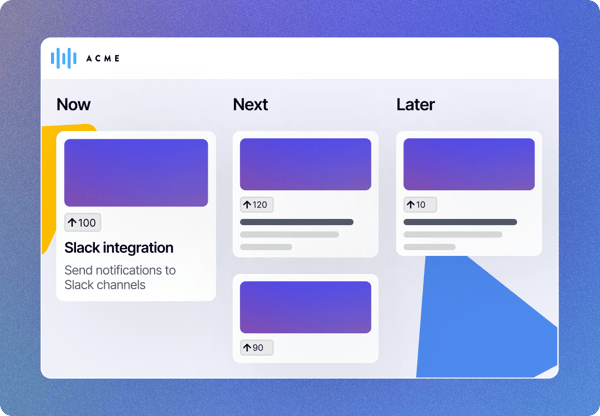
Types of Product Roadmaps
Product roadmaps can vary in format, including strategic roadmaps outlining long-term goals, feature-based roadmaps focusing on specific product features, and release-based roadmaps detailing timelines for product releases.
Goal-Oriented Roadmaps
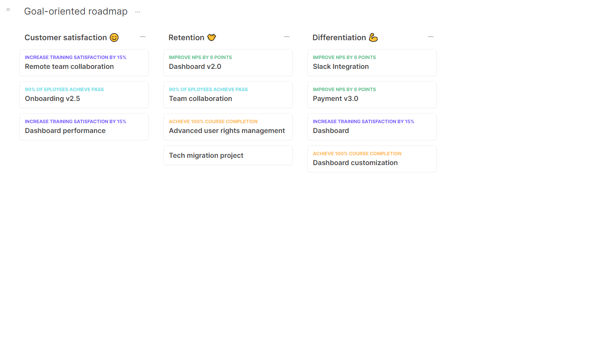
The goal-oriented product roadmap (GO) utilizes ‘goals’ to set out the foundations of the product plan. The GO product roadmap explains benefits and product outcomes including user acquisition and retention using ‘goals’ and ‘targets’, instead of features.
It offers a versatile approach to visualizing the product journey. Using the GO roadmap helps product teams state the goals of new products, their features, desirable metrics to be achieved, and the release timeframe.
Feature-Based Roadmaps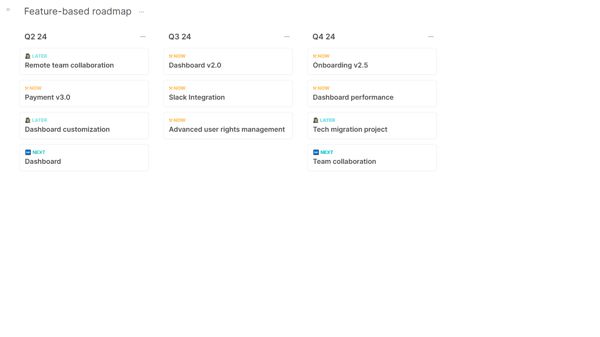
A feature-based roadmap is the most popular product roadmap. It provides an outline of features and characteristics which will be included in future product releases. Feature-based roadmaps allow stakeholders to track the development and release of the products, alongside a rough timeline. The feature output is the central point in creating the product roadmap, making it a more detailed document.
Timeline Product Roadmaps
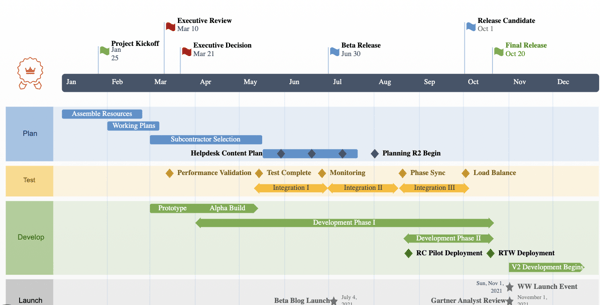 Image: Office Timeline
Image: Office Timeline
A timeline product roadmap provides a graphical structure of how several departments and deadlines are collaborating for a successful product strategy. A timeline product roadmap should only be used when there are multiple dependencies and deadlines to work with. This type of roadmap is ideally used to demonstrate the long-term vision of the product.
Analyzing Real-World Product Roadmap Examples
Analyzing real-world product roadmap examples offers valuable insights into industry best practices, strategic decision-making, and effective communication strategies for guiding product development.
Example 1: Agile Product Roadmap
An agile product roadmap offers great room for flexibility by showing how new technologies and products will evolve. The primary aim of agile product roadmaps is to showcase themes and progress. This roadmap points towards the adaptable and flexible nature of agile methodologies. With an agile product roadmap, you have a compass that points forward rather than a strict itinerary to stick to.
Agile product development is essential in a product roadmap as it allows for iterative feedback, flexibility in responding to market changes, and continuous improvement, enabling teams to adapt quickly and deliver value to customers efficiently.
Example 2: Product Launch Roadmap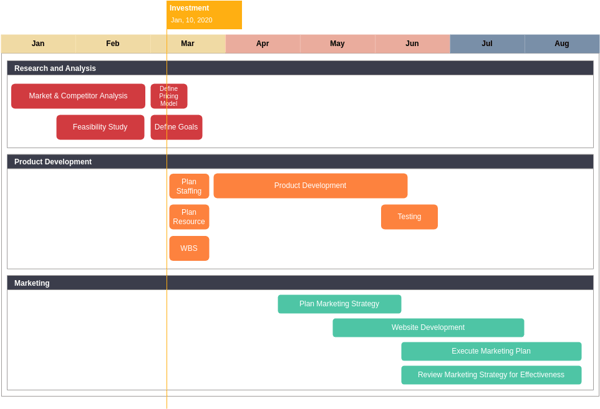 Image: Visual Paradigma Online
Image: Visual Paradigma Online
Using a product launch roadmap, you create a visually appealing depiction of how the new product will reach the target market. A product launch roadmap involves all departments and teams, including product development, sales, and marketing. From pre-launch to post-launch, this type of roadmap presents a step-by-step outline of all targets that have to be achieved in the product journey.
Example 3: Feature Release Roadmap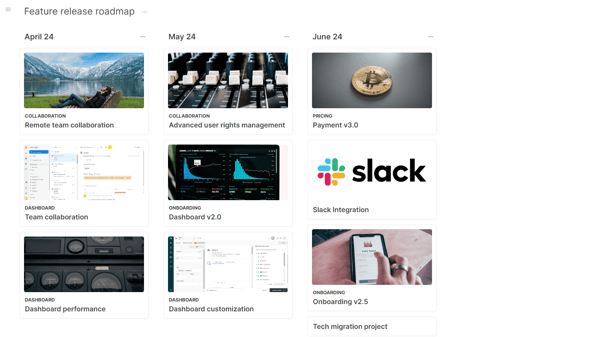
A feature release roadmap can be implemented to communicate the product’s progress and direction while tracking the release of key features. You can use feature roadmaps to prioritize key product resources and effectively handle resource allocation. A feature release roadmap ensures that you stay focused on products and projects that improve customer value.
Moreover, utilizing Harvestr's product roadmap tool can streamline your planning process and enhance the effectiveness of your product roadmap. Harvestr makes it convenient to keep control of the information that you would like to share and track your progress with infinitely customizable fields.
Best Practices for Creating a Product Roadmap
Aligning with Business Goals
Aligning a product roadmap with business goals allows the product direction to synchronize seamlessly with the large-scale aims and objectives of the organization. Product features should be aligned with the product vision to launch successful products that provide real value.
Here is a list of some simple ways using which you can align your product roadmap with business goals:
- Understanding business aims, objectives, and key performance indicators (KPIs).
- evaluating market trends and identifying customer needs
- focusing not only on product features but also on the value they offer
- integrating stakeholder input early in the planning stage
- using ‘objectives and key results’ (OKRs) to analyze impact and make changes as goals evolve
Furthermore, an important thing in this regard is product feedback. Product feedback is crucial in shaping a product roadmap as it provides valuable insights from users, guiding prioritization, feature development, and overall product direction to ensure alignment with customer needs and market demands.
Flexibility and Adaptability
Embrace flexibility and adaptability in your product roadmap because change is always an important part of the product development process. Executive stakeholders are interested in being continually updated about the product process. Technologies are also continuously evolving. Using product discovery interviews and conversations with buyers, teams also understand that customer priorities are also changing.
Hence, be ready to work with unpredictable development timelines in your product roadmap and communicate to your stakeholders flexibly.
Frequently Asked Questions (FAQs)
Which is an example of a product roadmap?
An example of a product roadmap could be a visual timeline outlining the key milestones, features, and enhancements planned for a software application over the next six months. It typically includes release dates, major updates, and strategic goals to guide development and communicate plans to stakeholders effectively.
What does a product roadmap include?
A product roadmap comprises the product vision, strategy, product requirements, an outline of the product plan, markers, and metrics. It may also incorporate feedback from stakeholders and customers, market analysis, and resource allocations to guide product development and iteration over time.
How do you create a simple product roadmap?
To create a simple product roadmap, begin by identifying your product vision and objectives. Next, prioritize features or improvements based on customer needs and market trends. Then, organize these items into phases or releases, considering resource availability and dependencies. Lastly, communicate the roadmap clearly to stakeholders for alignment and feedback.
What does a good product roadmap look like?
A good product roadmap is actionable, accurate, and visually appealing. It takes into account input from key stakeholders, customers, and team members. It provides a high-level, comprehensive overview of new product features and signifies prioritized areas to ignite interest in the product’s future direction.
Concluding Remarks
"Having a robust product feedback tool is crucial, and with Harvestr, you gain access to a suite of essential tools to effectively manage and develop successful products." Moreover, with Harvestr you will be open to uncountable ideas for product management and successful handling of any product.
